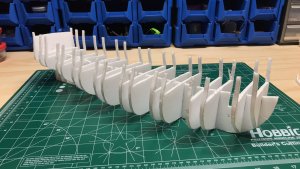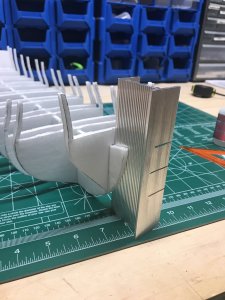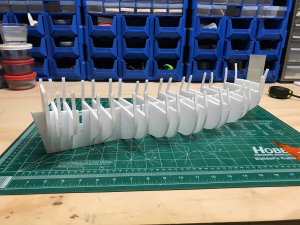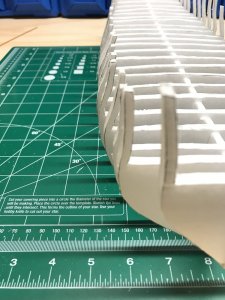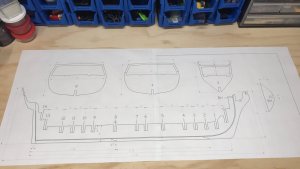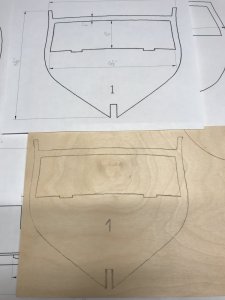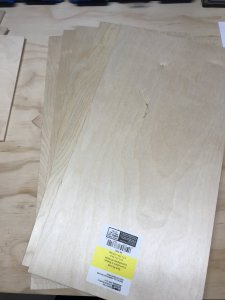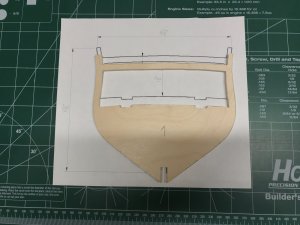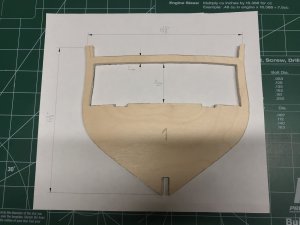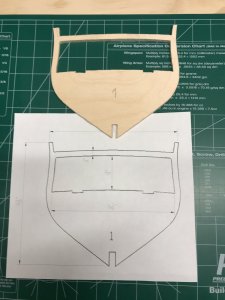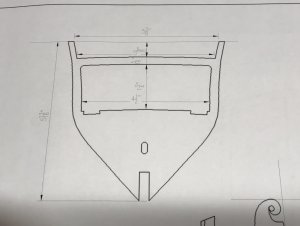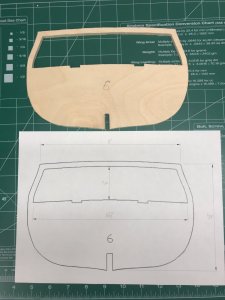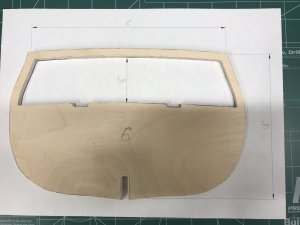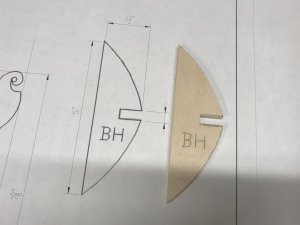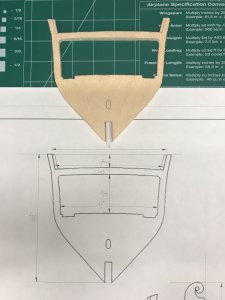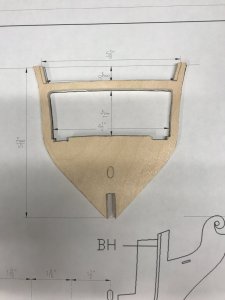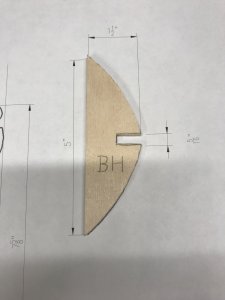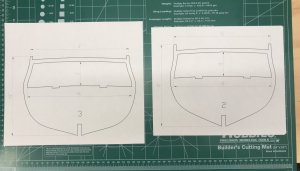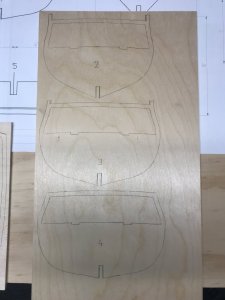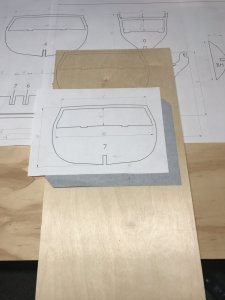-

Win a Free Custom Engraved Brass Coin!!!
As a way to introduce our brass coins to the community, we will raffle off a free coin during the month of August. Follow link ABOVE for instructions for entering.
You are using an out of date browser. It may not display this or other websites correctly.
You should upgrade or use an alternative browser.
You should upgrade or use an alternative browser.
HMS Ontario 1780 scale 1:32 POB full version
- Thread starter zoly99sask
- Start date
- Watchers 81
-
- Tags
- ontario sloop-brig
- Joined
- Dec 1, 2016
- Messages
- 6,338
- Points
- 728

when I do a bulkhead kit from scratch I will always build a foam board mockup, if anything has gone wrong I will see it in the prototype and make corrections.
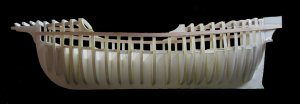
when looking at the bow the shape of the bulkheads from one to the other look like they would never make a nice smooth looking hull. The shapes look to drastic from one another.
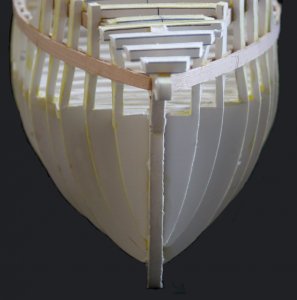
looking at a hull that has a drastic change in shape from one bulkhead to another
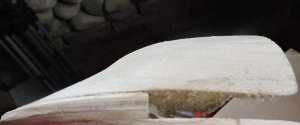
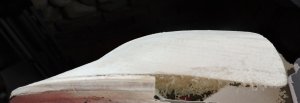
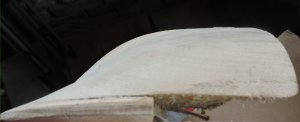
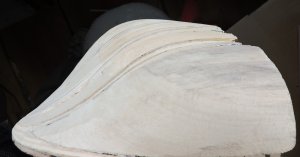
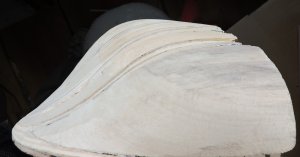
you would think looking at the bulkheads no way is this hull going to flow together but it does
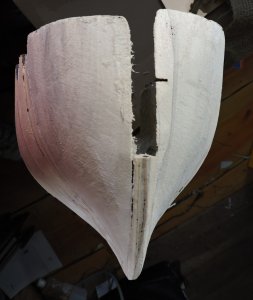
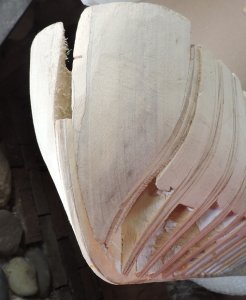
this is the reason bulkhead hulls built from kits often look like there are flat areas between bulkheads or the hull looks stepped from one bulkhead to another. Much of the transition shaping from bulkhead to bulkhead is taking place between the bulkheads. Another point to consider the shape of the bulkheads are NOT the final shape of the hull at that point they are just a general shape and measurement of the hull from center. The bulkheads lack the bevel and that will change drastic from keel to rail and from bulkhead to bulkhead.
At this point of the prototype I would fill the space between the bulkheads with foam board or the foam blocks you can get in the flower arrangement sections at any craft store. Then shape the entire hull and don't worry about sanding into the bulkheads, the biggest concern is getting the hull to flow from one bulkhead to the other producing smooth curves to the hull.
remember the original plans do not have hull lines in real ship building the final hull shape was done as the frames were erected this was called "dubbing" and battens were used to check flow of the hull lines. In model building it is the skill of the builder as you sand the hull you feel for low or high spots, use a sanding block that will span no less that 3 bulkheads and the final shaping is done with no blocks just a pad of sandpaper in your palm.
looks to me like this project is right on track
good work so far.

when looking at the bow the shape of the bulkheads from one to the other look like they would never make a nice smooth looking hull. The shapes look to drastic from one another.

looking at a hull that has a drastic change in shape from one bulkhead to another





you would think looking at the bulkheads no way is this hull going to flow together but it does


this is the reason bulkhead hulls built from kits often look like there are flat areas between bulkheads or the hull looks stepped from one bulkhead to another. Much of the transition shaping from bulkhead to bulkhead is taking place between the bulkheads. Another point to consider the shape of the bulkheads are NOT the final shape of the hull at that point they are just a general shape and measurement of the hull from center. The bulkheads lack the bevel and that will change drastic from keel to rail and from bulkhead to bulkhead.
At this point of the prototype I would fill the space between the bulkheads with foam board or the foam blocks you can get in the flower arrangement sections at any craft store. Then shape the entire hull and don't worry about sanding into the bulkheads, the biggest concern is getting the hull to flow from one bulkhead to the other producing smooth curves to the hull.
remember the original plans do not have hull lines in real ship building the final hull shape was done as the frames were erected this was called "dubbing" and battens were used to check flow of the hull lines. In model building it is the skill of the builder as you sand the hull you feel for low or high spots, use a sanding block that will span no less that 3 bulkheads and the final shaping is done with no blocks just a pad of sandpaper in your palm.
looks to me like this project is right on track
good work so far.
- Joined
- Dec 1, 2016
- Messages
- 6,338
- Points
- 728

these are examples of prototype hulls built the same way the Ontario is being built. The trick to the final shape is in the filler blocks between the bulkheads
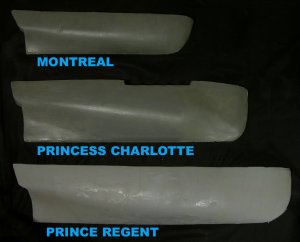
here is the bow section from the example in the last post
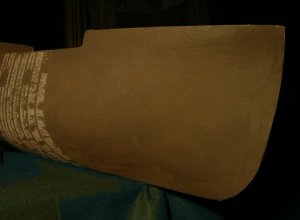
the reason the bulkheads look so drastic from one another in the last post is because of the hull shape. Looking straight on you can see the odd hull shape. These were frigate class ships built for the British on the Great Lakes by French and Irish shipwrights and they were call the super frigates built for speed and fire power.
What is interesting here is notice the flare outward at the bow at the sheer and in the picture above notice the hull tumbles inward. This would be difficult to achieve without filler blocks forming a smooth transition from bulkhead to bulkhead and even harder to plank the hull if there were only spaced out bulkheads.
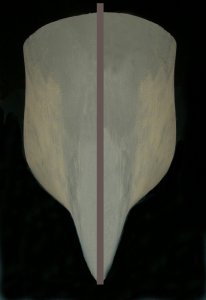

here is the bow section from the example in the last post

the reason the bulkheads look so drastic from one another in the last post is because of the hull shape. Looking straight on you can see the odd hull shape. These were frigate class ships built for the British on the Great Lakes by French and Irish shipwrights and they were call the super frigates built for speed and fire power.
What is interesting here is notice the flare outward at the bow at the sheer and in the picture above notice the hull tumbles inward. This would be difficult to achieve without filler blocks forming a smooth transition from bulkhead to bulkhead and even harder to plank the hull if there were only spaced out bulkheads.

- Joined
- Dec 1, 2016
- Messages
- 6,338
- Points
- 728

HMS Ontario 1780 - POB - scale 1/32
WOW! I just noticed from the topic title this is a tiny model maybe 3 inches total length
or do you mean 1:32 or 3/8 inch = 1 foot
1/32 scale is 1/32 inch = 1 foot
WOW! I just noticed from the topic title this is a tiny model maybe 3 inches total length
or do you mean 1:32 or 3/8 inch = 1 foot
1/32 scale is 1/32 inch = 1 foot
HMS Ontario 1780 - POB - scale 1/32
WOW! I just noticed from the topic title this is a tiny model maybe 3 inches total length
or do you mean 1:32 or 3/8 inch = 1 foot
1/32 scale is 1/32 inch = 1 foot
Lot bigger than that ,just the hull is 30 inch.
hello Zoly
3 buildings are you doing ....... do you sleep sometimes?


3 buildings are you doing ....... do you sleep sometimes?
hello Zoly
3 buildings are you doing ....... do you sleep sometimes?
Hello Dj, thanks for visiting my build log, no I am not building 3 ships, the Armed Virginia Sloop is already finished, just doing a build log for her.
Good morning everyone, I have some good news, I have received the plans from John Andela, the plans will be available for sale soon at The Art of Age of Sail website.
I have started prepping and copying the bulkheads on plywood.
Zoltan
I have started prepping and copying the bulkheads on plywood.
Zoltan
Last edited:
Hallo Zoltán,
Maybe you can tell us a little bit about this planset, most important the content and which scale?
Many thanks in advance....
Maybe you can tell us a little bit about this planset, most important the content and which scale?
Many thanks in advance....
Hallo Zoltán,
Maybe you can tell us a little bit about this planset, most important the content and which scale?
Many thanks in advance....
Hello Uwe the full length of the false keel with the stem and stern post is about 905 mm, lower gun deck is about 700mm at scale 1:32
The plans what I got so far from John is false keel, bulkheads, upper and lower deck layouts and an overall view of the ship.
Zoltan
I am estimating for now but the overall lenght will be around 110-120 cm.
Zoltan
Zoltan
A Hard work to cut all the bulkheads by hand........very good progress.....
I am following your log with big interest
I am following your log with big interest
A Hard work to cut all the bulkheads by hand........very good progress.....
I am following your log with big interest
Hello Uwe,actually not that bad just time consuming.
Zoltan

